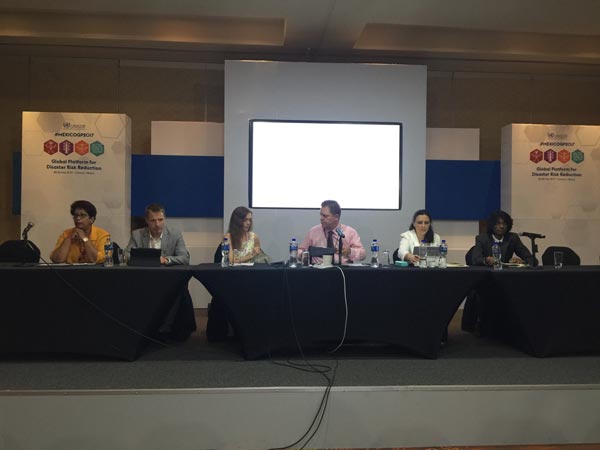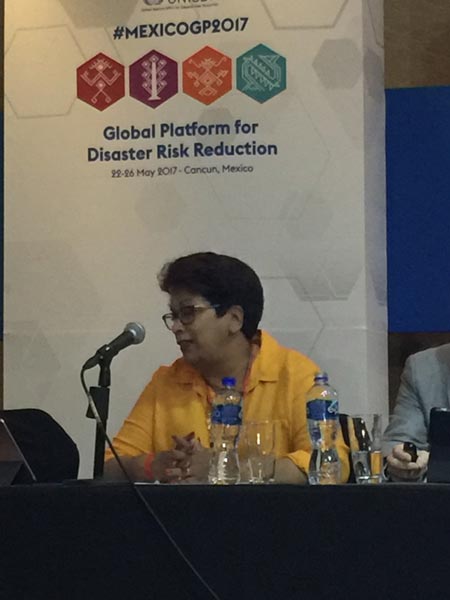As leaders of the UNISDR ‘Words into Action’ Working Group on Governance and Accountability, Professors Richard Haigh and Dilanthi Amaratunga were the key organisers and focal points of the session entitled “DRR Governance at the Local Level” held at the Local Government Summit Day at United Nations GLOBAL PLATFORM held in Cancun, Mexico in May 2017.
 Session panel
Session panelIt is the local government that is the first responder and the one responsible for community development and sustainable DRR. The empowerment of local governments should be a key priority in order to encourage democratic decision-making that involves the citizens and all key stakeholders at the local level. There is a need to identify mechanisms of implementation for the key elements of disaster risk reduction governance at the local level. It is also important to share examples and good practice, in particular related to multi-stakeholder participation, compliance and enforcement of DRR policies, transparency and accountability, responsiveness to stakeholders, consensus orientation, equity, effectiveness and efficiency, accountability, and strategic vision for reducing disaster risks.
Achieving local ownership for disaster risk governance depends on many factors, including interactions between communities and local actors in charge of implementing DRR policies. There are strong indications that many failings exist in attempts to practice decentralised disaster risk management at local government and community levels. Accordingly, there needs to be context specific risk governance arrangements in place to promote DRR at the local level. It is important to identify the challenges faced by local governments in implementing DRR.
The empowerment of local governments should be a key priority in order to encourage democratic decision-making in DRR that involves the citizens and all key stakeholders at the local level. A full understanding of disaster risk governance at the local level will need a thorough knowledge of the role of the various actors, and how they operate and invest in governance. In this context, this session will focus on the need and how to improve our understanding of risk governance at the local level.
This pre-event considered the need to improve understanding of risk governance at the local level, including accountability and transparency, sharing of risk information, stakeholder participation and public awareness, encouraging action on stakeholder feedback, and sharing best practices. It further:
- elaborated on some of the complex and challenging issues of risk governance at local level
- explored experiences, best practices and informal networks at the local government level.
- Took efforts to understand how local governments can be empowered, and governance can be reformed to ensure successful implementation of DRR initiatives at the local level.
- captured key points which can be used as input towards the next phase of the WiA on DRR governance at the local level in supporting the implementation of Sendai Framework
 Professor Dilanthi Amaratunga moderated the session
Professor Dilanthi Amaratunga moderated the sessionThis session was moderated by GDRC’s Professor Dilanthi Amaratunga. It’s Professor Richard Haigh was one of the Panelists along with Hans Guttman, Executive Director, Asian Disaster Preparedness centre, Thailand; Kathy Oldham, Head of Civil Contingencies and Resilience Unit, Association of Greater Manchester Authorities (AGMA), UK; Ebru Gencer, Executive Director, Center for urban Disaster Risk Reduction and Resilience (CUDRR+R), New York; Violeta Somera-Seva, General Secretary at Earthquakes and Megacities Initiative, National Capital Region, Philippines; and Emmanuel Raju, University of Copenhagen, Denmark
